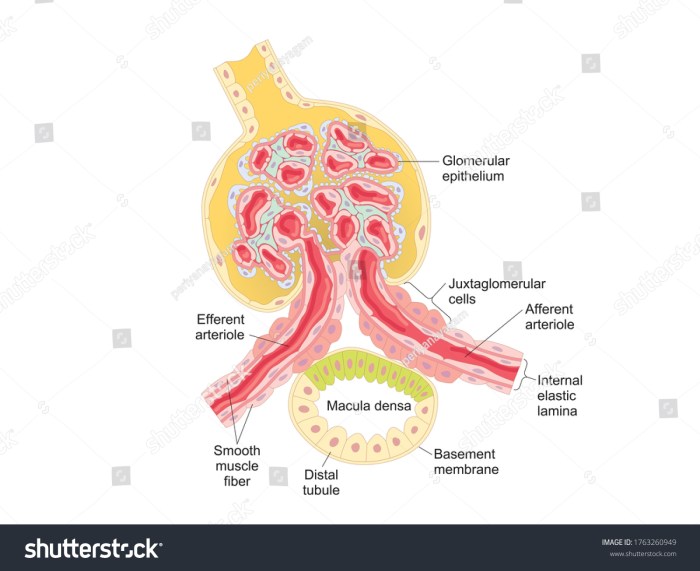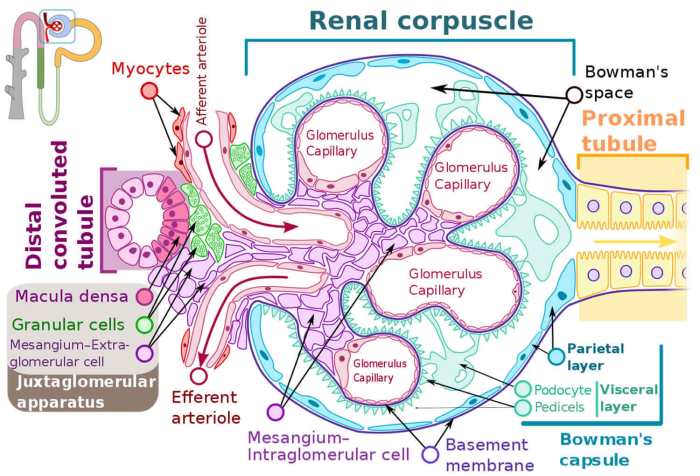Correctly label the components of the juxtaglomerular apparatus. – Embark on a scientific expedition as we delve into the intricate world of the juxtaglomerular apparatus (JGA), a specialized structure within the kidney responsible for regulating blood pressure. Our journey begins with a meticulous examination of its components, unraveling their functions and roles in maintaining homeostasis.
Join us as we explore the fascinating realm of the JGA, where knowledge and precision converge.
Define Juxtaglomerular Apparatus (JGA)
The juxtaglomerular apparatus (JGA) is a specialized structure within the kidney that plays a crucial role in regulating blood pressure and fluid balance. It is located at the point where the afferent arteriole enters the glomerulus, a small network of blood vessels that filters waste products from the blood.
The JGA consists of three main components: the glomerulus, the macula densa, and the juxtaglomerular cells.
Components of the JGA: Correctly Label The Components Of The Juxtaglomerular Apparatus.

Glomerulus
The glomerulus is a network of tiny blood vessels that filters waste products from the blood. It is surrounded by the Bowman’s capsule, which collects the filtered fluid and sends it to the renal tubules.
Macula Densa, Correctly label the components of the juxtaglomerular apparatus.
The macula densa is a specialized group of cells located in the distal convoluted tubule, just before the afferent arteriole enters the glomerulus. These cells sense changes in the concentration of sodium chloride in the tubular fluid.
Juxtaglomerular Cells
The juxtaglomerular cells are specialized cells located in the wall of the afferent arteriole. They secrete renin, an enzyme that plays a key role in regulating blood pressure.
Regulation of Renin Secretion

The JGA plays a crucial role in regulating renin secretion. Renin is released in response to decreased blood pressure, decreased blood volume, or increased sympathetic nerve activity. The macula densa senses changes in sodium chloride concentration in the tubular fluid and sends signals to the juxtaglomerular cells, which then release renin.
Renin acts on angiotensinogen, a protein produced by the liver, to form angiotensin I. Angiotensin I is then converted to angiotensin II by angiotensin-converting enzyme (ACE), which is found in the lungs. Angiotensin II is a potent vasoconstrictor, which means it causes blood vessels to narrow.
This increases blood pressure and restores blood volume.
Clinical Significance of the JGA

Dysfunction of the JGA can lead to a number of clinical conditions, including:
- Hypertension (high blood pressure)
- Hypotension (low blood pressure)
- Renal artery stenosis (narrowing of the renal artery)
- Glomerulonephritis (inflammation of the glomerulus)
Understanding the JGA can aid in the diagnosis and treatment of these conditions.
Histological Examination of the JGA
The JGA can be visualized and examined using a variety of histological techniques. These techniques include:
- Light microscopy
- Electron microscopy
- Immunohistochemistry
Histological analysis of the JGA can help to diagnose JGA-related disorders and to assess the severity of the condition.
Common Queries
What is the primary function of the juxtaglomerular apparatus?
The juxtaglomerular apparatus plays a crucial role in regulating blood pressure by controlling renin secretion, which in turn initiates the renin-angiotensin-aldosterone system.
How does the macula densa contribute to the regulation of renin secretion?
The macula densa, a specialized region of the distal convoluted tubule, detects changes in sodium chloride concentration and communicates this information to the juxtaglomerular cells, modulating renin secretion accordingly.